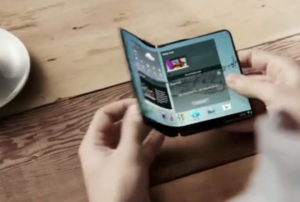Mobile phones have to be one of the most stunning pieces of technology ever offered to consumers. The evolution of the phone, something which has become an everyday tool to get us what we want, and, perhaps even more importantly social acceptance of the technology has been pervasive. With so much change from phone innovation, it is almost impossible not to feel an element of fear for the future. After all, it seems like everything that should be included into a mobile phone has found its way there already.
Basing our thoughts on past features, possible improvements and where new technology is leading, here are some of the things we might be wowing us in future phone released.
We finish the article by summarizing the two axis on which phone manufacturers are advancing their creations and speculate on the end point for mobile phones.
1 Improved aesthetics including foldable screens
When you look at models such as the Galaxy S range, there was the introduction of curved screen variants some few years ago. The line-up migrated to a point where it now only offers its curved screens – flatter alternatives – still the only products Apple offer are just not available from Samsung. Curved screens, are the major feature which have reduced the size of ‘bezels’ (the frame which holds the screen on to the device). Many Samsung are now sold with the ‘bezel-less’ tag.
One of the things that these manufactures will keep working towards is providing you as much screen real estate as is humanly possible. Which is why, another heavily-touted technology which has been in the works for some years now is that of fold able phones.
The world has enjoyed the feature phone, flip, physical keyboard and full-screen form factors for long before we had smartphone. It was really only with the release of the first iPhone that we started to become used to a black screen as our phone interface.

Caption: Samsung have been working on fold able screens for a while now – to accentuate their differentiation from Apple. The first phone with a truly fold able screen is set to be with us later in 2018.
Samsung, accentuating their existing differentiation from Apple, have been working on foldable screens for some time now. In fact, the technology to produce them has been available for a while. It’s actually the connectors and sensors required to unify the screen with the rest of the phone that have proved the harder nut to crack. Samsung hope to bring a phone with a fold able screen to market before the end of the calendar year.
2 Battery life improvements
One of the elements of modern smartphones which regularly tops the list of features that users would like to see improved, is battery life. Users want it both ways and they don’t want to worry about the technical complexity of eking out the performance of their device’s power – they just want it all to work.
Manufacturers recognize this problem and have historically tried to fix the problem simply by trying to fit bigger batteries in to their handsets. The issue is, the phones now have better processes which drain the battery even faster.
Engineers are rising to the challenge. Take, for example, the recent Apple iPhone XS launch – a phone which had no less than 3 different processors (one of which had 6 cores!) This year’s device was designed specifically to both improve performance (the speed with which the phone responds to a human input), and, also to extend the battery performance of the phone. Impressively, Apple claim the new device will benefit from something between half of and one hour’s improved time.
The phones of the future might solve that with new battery models. These could come with hydrogen cells or nanobattery technology. They could even eliminate the need for chargers with an incorporation of technology that juices up your phone via kinetic or solar energies.
3 Improved Virtual Assistants (VA) and Voice Interfaces
Potentially one of the most immediate opportunities to evolve the Smart Phone is the fast improving speech recognition which is being added in to phones. VAs like Siri and Google’s Personal Assistant represent a huge shift in the way we interact with technology
When VA tech first came to phones, the market was not exactly receptive. Why ask a piece of software to do something that you had been managing quite well for years – especially when a lot of the time, users received less accurate answers than if they’d just typed their request in themselves?
A few years down the line, however, with multiple improvements, over multiple generations of the technology, the story has changed. Voice recognition is now at the point where it is on a par with human level understanding what the user wants, even when the verbal expression is provided in an area with a lot of background noise. In China, already more than 25% of searches on Baidu (their Google) are done verbally.
Users can now launch any service and perform almost any task with their in-built assistant services and, as the data sets available from this increasingly large group of users, accuracy and comprehension will only get better.
Just what, exactly, is a phone?
When mobile phone networks were originally built, they were designed to carry the human voice over a distance. That’s very different to what they are doing now. Almost all our interactions with our smartphones are performed with our hands, on a touchscreen interface to the internet.
It was really BlackBerry – the makers of the email phone that was popular a decade and a half ago, who took us down the first faltering steps of a permanent connection to the internet.
Manufacturers are focusing on improving phones along two axis. First, they are attempting to fix battery performance in phones.
On the other axis, Samsung, Apple, LG and others are looking to the future of our mobile interface to the internet. 5G is nearly here, and will offer speeds between 10 times and 100 times what we currently receive (when what we currently receive is High Definition video.) Voice Assistants and Virtual Reality capabilities are more human ways for us to connect to the internet.
Ultimately, what we call a phone may well be as small as a ball bearing and inserted in to our bodies, letting us talk to it, so it knows what we want and giving us results in a virtual replication of whatever environment will help us achieve our goals in the moment.
Read Also:










